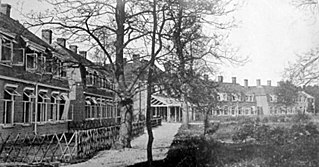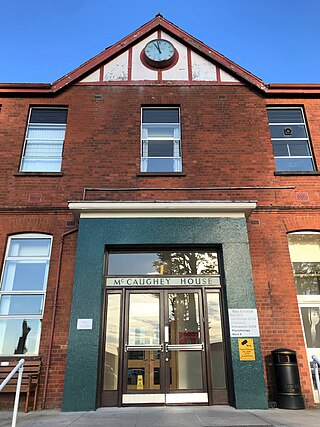Related Research Articles

A sanatorium, also sanitarium or sanitorium, are antiquated names for specialised hospitals, for the treatment of specific diseases, related ailments and convalescence. Sanatoriums are often in a healthy climate, usually in the countryside. The idea of healing was an important reason for the historical wave of establishments of sanatoriums, especially at the end of the 19th- and early 20th centuries. One sought, for instance, the healing of consumptives, especially tuberculosis or alcoholism, but also of more obscure addictions and longings of hysteria, masturbation, fatigue and emotional exhaustion. Facility operators were often charitable associations such as the Order of St. John and the newly founded social welfare insurance companies.

The Waverly Hills Sanatorium is a former sanatorium located in the Waverly Hills neighborhood of Louisville, Kentucky.
Piedmont Sanatorium was a rest home for tubercular African Americans in Burkeville, Virginia from 1917 to 1965. It was the first facility of its kind ever to be established in the United States. The Sanatorium later became the site of Piedmont Geriatric Hospital.

Lanchester Road Hospital is a mental health facility located in County Durham, England, and lies on a large site just north west of Durham city. It is managed by the Tees, Esk and Wear Valleys NHS Foundation Trust.

Henryton State Hospital is a now-demolished hospital complex in Marriottsville, in southern Carroll County, Maryland, just across the Howard County line. The complex was located within Patapsco Valley State Park and along its southern end runs CSX's Old Main Line Subdivision and is very close to the Henryton Tunnel. The Henryton State Hospital center, or the Henryton Tuberculosis Sanatorium as it was called, was erected in 1922 by the Maryland Board of Mental Hygiene. It was established as a facility to treat African Americans suffering from tuberculosis. This was one of the first such facilities in Maryland erected to provide African Americans with the same level of treatment as white people. Other accounts state that this was more of containment Hospital rather than a treatment facility. They contend that Henryton was used more for the exile and quarantine of tuberculosis patients.

Glen Lake Sanatorium, a tuberculosis treatment center serving Hennepin County in Minnesota, opened on January 4, 1916, with a capacity of 50 patients, and closed in 1976. In 1909, the Minnesota State Legislature had passed a bill authorizing the appointment of county sanatorium boards and appropriating money for the construction of county sanatoriums. Glen Lake Sanatorium was the fifth of fourteen county sanatoria that opened in Minnesota between 1912 and 1918. Glen Lake was the first U.S. tuberculosis sanatorium to be accredited by the American Medical Association.The sanatorium had its own post office, and the mailing address was Glen Lake Sanatorium, Oak Terrace, Minnesota, until the surrounding area was incorporated into the City of Minnetonka.

Danville State Hospital in Danville, Pennsylvania is a mental health facility operated by the Pennsylvania Department of Public Welfare. It was Pennsylvania's third public facility to house the mentally ill and disabled.

The Seaside is a historic medical facility at 36 Shore Road in Waterford, Connecticut. It is nationally significant as the first institution designed for heliotropic treatment of children suffering from tuberculosis. Its buildings "comprise an exceptional collection of fully realized and generally well-preserved Tudor Revival-style institutional architecture", which were designed by Cass Gilbert. The property was listed on the National Register of Historic Places in 1995.
Fort William Sanatorium was a tuberculosis hospital or sanatorium in Fort William, Ontario, today part of the city of Thunder Bay. It opened in 1935 as a tuberculosis treatment centre for settlers, adding 20 government-funded beds for Indigenous patients in 1941.

Lawrence Francis Flick (1856–1938) was an American physician who pioneered research and treatment of tuberculosis. He was influential as an author, lecturer, and historian. He is a co-founder of the National Association for the Study and Prevention of Tuberculosis and was the first to advocate its formation as early as 1898.

Hawkmoor Hospital, originally known as Hawkmoor County Sanatorium, was a specialist hospital near Bovey Tracey in Devon, England, founded in 1913 as a pulmonary tuberculosis sanatorium as part of a network of such facilities, instigated by the Public Health 1912. From 1948, the hospital catered for patients with a range of chest ailments, as well as chest surgery, and mental disability patients. From 1973, the facility dealt solely with mental health problems until its closure in 1987.
The Rutland Heights State Hospital was a state sanatorium for the treatment of pulmonary tuberculosis located in Rutland, Massachusetts, USA built for the purpose of treating Tuberculosis patients. The facility was the first state-operated sanatorium in the United States, opening in 1898 and operating for around 93 years before its closure in 1991. Rutland Heights opened under the title “Massachusetts Hospital for Consumptives and Tubercular Patients,” to which it operated until 1900, where it was renamed to “Massachusetts State Sanatorium.” In 1919 it was renamed to “Rutland State Sanatorium,” which was the longest operating name of the hospital, effective until 1963. In 1963, it was renamed briefly to “Rutland Hospital,” and successively in 1965 to “Rutland Heights State Hospital,” which was the final title of the hospital until closing. In 2004, the hospital was demolished.

The Minnesota State Sanatorium for Consumptives, also known as the Ah-Gwah-Ching Center, was opened in 1907 to treat tuberculosis patients. The name "Ah-Gwah-Ching" means "out-of-doors" in the Ojibwe language. The center remained a treatment center for tuberculosis until January 1, 1962. During that time, it treated nearly 14,000 patients. In 1962, it became a state nursing home known as the Ah-Gwah-Ching Nursing Home, serving geriatric patients with various mental and physical illnesses. At its peak in the 1970s, the nursing home had as many as 462 patients.
The town of Colorado Springs, Colorado, played an important role in the history of tuberculosis in the era before antituberculosis drugs and vaccines. Tuberculosis management before this era was difficult and often of limited effect. In the 19th century, a movement for tuberculosis treatment in hospital-like facilities called sanatoriums became prominent, especially in Europe and North America. Thus people sought tuberculosis treatment in Colorado Springs because of its dry climate and fresh mountain air. Some people stayed in boarding houses, while others sought the hospital-like facilities of sanatoriums. In the 1880s and 1890s, it is estimated that one-third of the people living in Colorado Springs had tuberculosis. The number of sanatoriums and hospitals increased into the twentieth century. During World War II, medicines were developed that successfully treated tuberculosis and by the late 1940s specialized tuberculosis treatment facilities were no longer needed.

Ethan Allen School for Boys was a reform school in Delafield Town, Wisconsin which operated in a former tuberculosis sanitorium from April 1959 until June 2011, when it was abolished and the inmates moved to Lincoln Hills School in Irma. It was operated by the Wisconsin Department of Corrections.
John E. Streltzer was a legislator in the U.S. state of Colorado, philanthropist, and former U.S. Director of Customs for Colorado and Wyoming.

The Firland Sanatorium was Seattle's municipal tuberculosis treatment center. It opened on May 2, 1911, and closed on October 30, 1973.

The Pinewood Hospital was a hospital in Pinewood, near Crowthorne, England, for the treatment of people suffering from tuberculosis. It was located in a pine wood as pine trees were thought to be beneficial in the treatment of the disease. It opened as the London Open Air Sanatorium in 1901 before becoming the Pinewood Sanatorium. It treated casualties of the First and Second World Wars and after the second, began to treat general thoracic patients as tuberculosis became less prevalent. It closed in 1966.

Whiteabbey Hospital is a hospital located close to the village of Whiteabbey, within the town of Newtownabbey, Northern Ireland. The hospital first opened in 1907 as The Abbey Sanitorium, centred around a country house known as 'The Abbey'. The house has stood on the site from 1850, and was once the residence of prominent architect Charles Lanyon. The hospital was extended and several buildings added throughout the early 20th century, and it was renamed Whiteabbey Hospital in 1947. The hospital is managed by the Northern Health and Social Care Trust. Many healthcare services have been withdrawn from the hospital, most recently with the closure of the Minor Injuries Unit in 2014.

Blue Ridge Sanatorium was a sanatorium for the treatment of tuberculosis located outside of Charlottesville, Virginia, United States.
References
- ↑ Asylum Projects.org - Lawrence Frick State Hospital(Retrieved:5/6/2011)